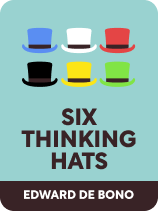

This article is an excerpt from the Shortform book guide to "Six Thinking Hats" by Edward de Bono. Shortform has the world's best summaries and analyses of books you should be reading.
Like this article? Sign up for a free trial here .
Would you like to make decisions faster? Is your internal critic way too loud?
In Six Thinking Hats, Edward de Bono takes the phrase “put your thinking cap on” to a new level. Our normal thinking process is a hopeless tangle of six types of thinking. We can improve the quality and efficiency of our decisions by untangling these six types and deploying them more consciously.
Continue reading for Six Thinking Hats exercises that will help you implement the ideas in the book.
Six Thinking Hats Exercises
Six Thinking Hats teaches you how to incorporate factual, emotional, critical, constructive, creative, and metacognitive information into your thinking process, along with strategies you can use to generate ideas in each of these modes. If you’re looking for ways to dramatically cut your decision-making time, calm your inner critic, or increase your team’s creativity, the Six Hats method can help. The following Six Thinking Hats exercises make it simple. Ready to try on some hats?
Exercise #1: Try on the Blue Hat
Create a draft meeting agenda or thinking plan based on the six hats.
- Write down either: (1) a problem you’re currently facing at work, or (2) a problem outside of work that you think might be amenable to the Six Hats method.
- Consider the function of each of the six hats: The blue hat is for procedure, the white hat is for information, the red hat is for emotion, the black hat is for criticism, the yellow hat is for constructive thinking, and the green hat is for new ideas.
- Put on your blue hat. Which of the above do you think should be addressed first and why?
- Sketch a plan for the whole thinking process. Remember to touch on each hat at least once. Feel free to circle back to important hats as many times as you like.
Exercise #2: Try on the White Hat
Work with the white hat on a problem of your choice.
- Think of a decision you currently face, either at work or elsewhere in your life. What objective information will help you to make an informed choice? (Be as general or as specific as you like, but mark any general information that needs further investigation or confirmation.) Try to prevent any interpretations or emotions from sneaking in.
- What important information is missing? What have you noted that seems vague or out of date?
- Evaluate the information you’ve noted above. Is it genuinely balanced (might you have unconsciously selected it to favor one side or the other)? How might you go about finding some balancing information?
Exercise #3: Try on the Red Hat
Work with the red hat on a problem of your choice.
- Consider the project or initiative that you started thinking about in the last exercise. What emotions do you feel about this issue? Remember, no explanations or justifications are necessary.
- What intuition do you have about this project, based on previous experience?
- What’s your gut feeling about how this will all turn out?
Exercise #4: Try on the Black Hat
Work with the black hat on a problem of your choice.
- Consider the project or initiative that you’ve been thinking about in previous exercises. What design flaws can you spot? What are the weaknesses in the current approach as it stands right now?
- Think of some similar initiatives that have failed in the past. What went wrong?
- What could go wrong with your project? List all of the possibilities you can think of. Be as harsh and critical as you can.
Exercise #5: Try on the Yellow Hat
Work with the yellow hat on a problem of your choice.
- Consider the project or initiative that you’ve been thinking about in previous exercises. What design flaws and weaknesses did you identify with the black hat? List the main ones. For each flaw or weakness, put on your yellow hat and see if you can find ways to strengthen or overcome the weakness.
- Think again about this project or initiative. What’s the underlying problem that it’s trying to solve? Can you come up with another way to solve it?
- What’s the best possible outcome for your project? If everything goes right for the project, what would that look like?
Exercise #6: Try on the Green Hat
Po, standing for “provocative operation,” is a word you can use to signpost a provocation. The deal is that you’re not allowed to meet a po with a black hat—you have to run with the suggestion. Here are some examples of po:
- Po roads should have a special motorbike lane.
- Po we should get rid of the whole HR department.
Work with the green hat on a problem of your choice.
- Consider the project or initiative that you’ve been thinking about in previous exercises. What’s the main issue? Can you sum it up in a few words?
- Put aside the specifics of the project for a moment. What completely new ideas can you come up with in this general area? Give yourself two minutes to start with, and keep going if you’re still generating ideas at the two-minute mark.
- Try out “reversal” po. Reverse one of the key tenets of your project and see what happens. For example: “My project is about koala habitat conservation. What if the koalas protected their own habitat?” (This could lead to a campaign where people learn about specific koala individuals and sponsor them, or to educational programs where kids learn about koala conservation from instructors dressed as koalas.)
- Try out “random association” po. For example, let’s say your project is about koala habitat and your random word is “spider.” Perhaps this reminds you of a spiderweb, and a spiderweb reminds you of networks, and this leads you to a social media campaign or a project to link different organizations working on koala conservation.

———End of Preview———
Like what you just read? Read the rest of the world's best book summary and analysis of Edward de Bono's "Six Thinking Hats" at Shortform .
Here's what you'll find in our full Six Thinking Hats summary :
- A handbook for training people to think more efficiently and productively
- An explanation of each of the six thinking hats created by Edward de Bono
- How to calm your inner critic and dramatically cut your decision-making time






